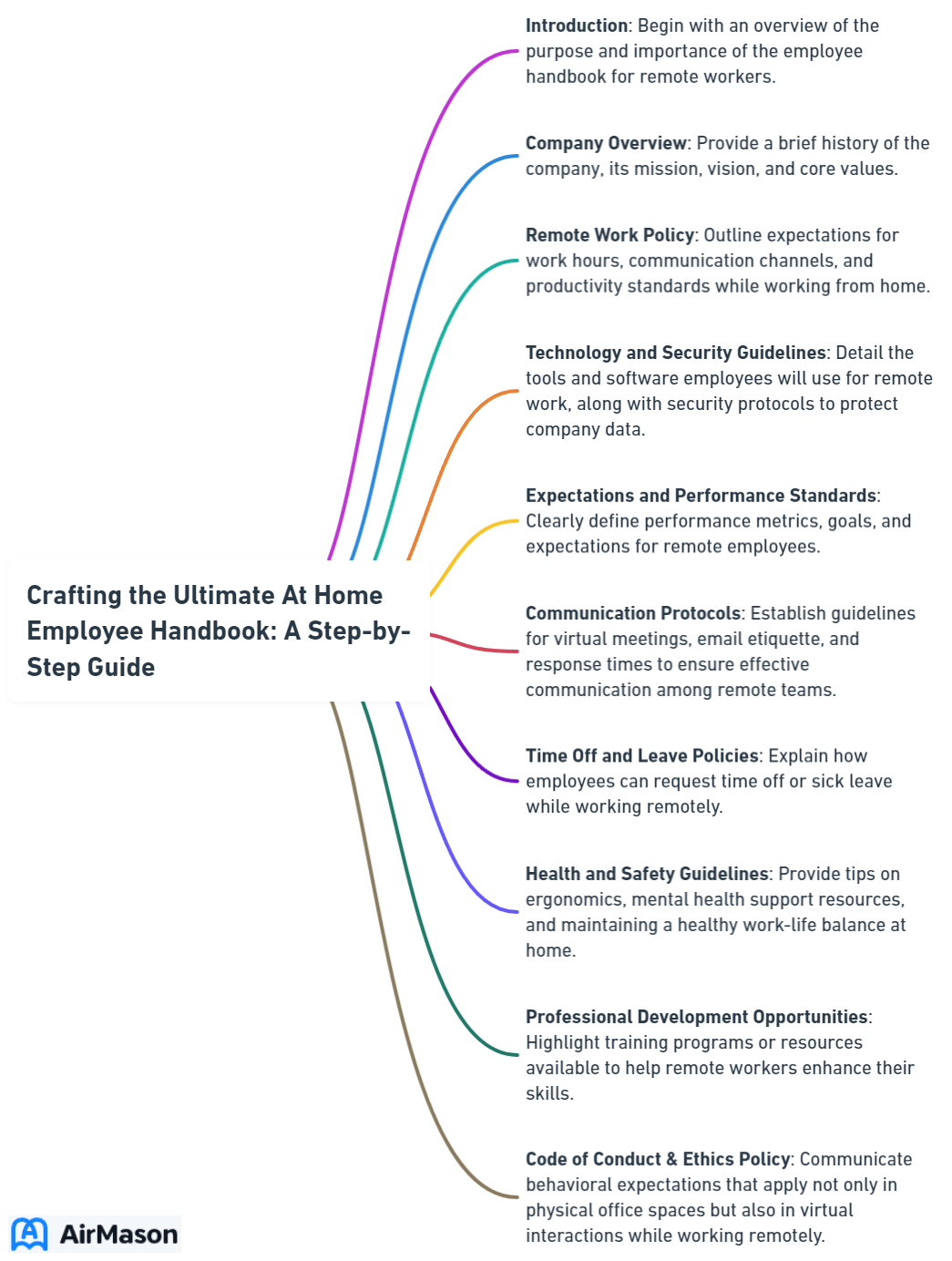
When managing a remote workforce, the right at home employee handbook can set the stage for success. But what should be included, and how do you ensure it’s followed? This article offers detailed guidance, from outlining clear work-from-home policies to enhancing remote worker engagement, ensuring your team stays productive and connected.
Key Takeaways
- A comprehensive at-home employee handbook is essential for setting clear expectations and guidelines for remote workers, covering roles, work-from-home policies, and leave entitlements.
- Employers must ensure legal compliance in remote work policies, including workers’ compensation, safety measures, data protection, and adapt the handbook to changing laws and standards.
- Effective remote workforce management involves enhancing employee engagement through virtual socialization and career development, ensuring effective communication, addressing unique remote work challenges, and building trust through accountability and performance management.
Employee Handbook Updates
Employee Handbook Updates are essential for keeping your company policies current and compliant with regulations. Regularly revising the handbook ensures that employees are aware of any changes in company policies, procedures, or benefits. It also serves as a reference guide for both employees and managers, fostering clarity and consistency in the workplace. When implementing updates, it’s crucial to communicate changes effectively to all staff members and provide ample opportunity for questions or clarification. Additionally, seeking input from employees can improve the relevance and effectiveness of the handbook, promoting a sense of ownership and engagement. By staying proactive with updates, you can maintain a positive work environment and mitigate potential conflicts or misunderstandings.
1 Crafting Your At Home Employee Handbook: The Essentials
Creating an employee handbook is a key step in establishing clear guidelines and expectations for your remote workforce. It serves as a reference point for employees, providing clarity on their roles and responsibilities, work-from-home guidelines, and leave policies. Such a handbook promotes a harmonious working relationship and aids in mitigating potential misunderstandings and disputes.

Defining the Employment Relationship
The employment relationship in a remote work setting differs significantly from that of a traditional office environment. Remote employees, including new employees and existing employees who transition to remote work, operate with greater independence, often completing tasks with minimal supervision. Outlining their roles and responsibilities clearly in the employee handbook is pivotal for fostering productivity and preventing confusion or miscommunication.
Establishing Work-from-Home Guidelines

Working from home presents its own set of challenges, from time management to maintaining work-life balance. Clear and specific work-from-home guidelines can help address these issues, ensuring that employees remain productive without compromising their well-being. These guidelines should be fair, align with office standards, and be communicated effectively to all employees.
Clarifying Leave Policies
In a remote work environment, it’s essential to inform employees and elucidate leave policies as part of effective management. Whether it’s sick leave, vacation, or family leave, employees need to understand their entitlements and obligations. This shapes employee behavior, ensures adherence to company policies, and fosters a fair and transparent working environment.
Navigating Legalities and Compliance
Employers must tread carefully when it comes to legal compliance in the realm of remote work. This encompasses workers’ compensation, safety measures, and the protection of company information. Ensuring that your remote work policies are in line with state and federal laws is not just about avoiding penalties—it’s about maintaining a safe and fair work environment for all.
Workers’ Compensation and Safety

Workers’ compensation is a crucial consideration for remote employees. If an employee sustains a work-related injury or illness while performing job duties during work hours, they may be eligible for workers’ compensation benefits.
Employers should also encourage ergonomic best practices to ensure a comfortable and productive workspace, minimizing the risk of work-related injuries and strains.
Protecting Company Information
Protecting company information gains heightened importance in a remote work setting. Employers can safeguard their data by:
- Employing a VPN
- Providing cybersecurity training
- Using online backup services
- Implementing multi-factor authentication
Such measures not only safeguard sensitive company data but also contribute to maintaining the company’s reputation and customer trust as the nation’s premier provider.
Enhancing Employee Engagement from Afar
Employee engagement is a key factor in the success of a remote workforce. By fostering virtual socialization and providing career development opportunities, employers can ensure that their remote employees feel valued and connected, which in turn, boosts their productivity and job satisfaction.
Nonprofit Handbook
The Nonprofit Handbook serves as an essential guide for organizations navigating the complexities of the nonprofit sector. Within its pages, nonprofit leaders can find valuable insights, best practices, and practical strategies to effectively manage their operations and fulfill their missions. From governance and fundraising to volunteer management and program development, the Nonprofit Handbook offers comprehensive resources tailored to the unique needs of charitable organizations. With expert advice and real-world examples, this handbook equips nonprofits with the knowledge and tools necessary to thrive in today’s ever-changing landscape. Whether you’re a seasoned nonprofit professional or just starting your journey, the Nonprofit Handbook is an indispensable resource for achieving organizational success and making a lasting impact in your community.
Encouraging Virtual Socialization

In a remote work environment, fostering a sense of community can be challenging. However, with the right strategies, employers can promote virtual socialization, helping remote workers feel more connected to their colleagues. Such strategies enhance team dynamics and foster a positive work culture.
Supporting Career Development
Career development is a vital aspect of employee engagement. By providing resources and support for career growth, employers convey the message that they value their employees’ professional development. This motivates employees and elevates their overall engagement with the company.
Constructing Clear Communication Channels
Effective communication is the backbone of a successful remote team. Clear and consistent communication ensures that everyone is on the same page, reducing the chances of misunderstandings and confusion. Establishing clear communication channels and setting expectations for remote employees is crucial.
Setting Expectations for Availability
In a remote work setting, availability and responsiveness can sometimes be a grey area. By setting clear expectations for availability and responsiveness, employers can ensure that there’s a balance between flexibility and accountability. This aids in smooth team collaboration and instills a sense of discipline among remote workers.
Utilizing Technology for Collaboration
Technology plays a pivotal role in enhancing collaboration among remote teams, providing a competitive advantage. With the right tools and platforms, teams can collaborate in real-time, regardless of their geographical location, facilitating seamless communication and productivity.
Addressing Unique Aspects of Remote Work
Remote work comes with its own unique set of challenges and aspects, such as expense reimbursement and home office setup. Employers can guarantee a smooth and hassle-free remote work experience for their employees by addressing these aspects and providing clear guidelines.
Expense Reimbursement and Supplies
Expense reimbursement is a key consideration for remote employees. Whether it’s internet access, phone bills, or office supplies, employers should have clear policies in place for expense reimbursement, ensuring that employees are not burdened with work-related costs.
Home Office Setup and Ergonomics

A well-organized home office setup significantly impacts the productivity and well-being of remote employees, ultimately affecting business operations. By offering guidance on in home care, home office setup, and ergonomics, employers can promote a healthy and productive work environment, reducing the chances of work-related injuries and strains.
Building Trust and Accountability
Trust and accountability are fundamental pillars of a successful remote team. With the right performance management strategies and procedures for addressing misconduct, employers can foster a sense of trust and accountability among remote employees, contributing to a harmonious and productive work environment. In fact, treating each remote employee as a valued family member can further enhance this sense of trust and accountability, especially when offering benefits such as paid time off. Consultation with a legal team may be necessary to ensure compliance with relevant laws and regulations.
Performance Management
Performance management is a key aspect of managing remote employees. From setting clear goals and expectations to providing regular feedback and recognition, effective performance management ensures that employees are aligned with the company’s goals and objectives and are performing to their full potential.
Addressing Misconduct
Misconduct in a remote work setting can be challenging to address. However, with clear standards of conduct and a uniform reporting process, employers can effectively handle misconduct, maintaining a safe and respectful work environment for all.
Adapting Your Handbook Over Time
An employee handbook, also known as an employee manual, is not a static document. It needs to evolve and adapt over time to ensure it remains relevant and compliant with current policies and procedures. Regular reviews, updates, and employee feedback are crucial in this process. Looking at employee handbook examples can provide inspiration and guidance for creating or updating your own handbook.
Regular Review and Updates
Regularly reviewing and updating the employee handbook ensures that it remains aligned with current laws and industry standards. Regular review and updates not only reduce the risk of litigation but also ensure the handbook continues to accurately reflect the company’s values and expectations.
Feedback Loop with Employees
Employee feedback is a valuable resource for improving the at-home employee handbook. Encouraging feedback and input from employees ensures the handbook remains relevant and effective, echoing the needs and concerns of the remote workforce.
MN Employee Handbook Template
Are you in need of a comprehensive MN employee handbook template to streamline your company’s policies and procedures? Look no further. Crafting an effective handbook is crucial for ensuring clarity and consistency across your organization. Our MN employee handbook template offers a structured framework tailored to meet the specific legal requirements and cultural nuances of Minnesota. From employment policies to code of conduct guidelines, our template covers essential aspects to govern your workforce effectively. With this resource, you can establish clear expectations, promote a positive work environment, and mitigate potential legal risks. Customize and implement our MN employee handbook template to foster a productive and compliant workplace environment for your team.
Summary
In conclusion, an at-home employee handbook is a vital tool for managing a remote workforce. From defining employment relationships and work-from-home guidelines to fostering employee engagement and constructing clear communication channels, a comprehensive handbook ensures a productive and harmonious remote work experience. As the world continues to embrace remote work, employers must adapt and update their handbooks to stay relevant and compliant, fostering a culture of trust, accountability, and continuous improvement.
Frequently Asked Questions
What is legally required in an employee handbook?
An employee handbook is legally required to cover topics such as minimum wage, anti-discrimination policies, safety regulations, time off policies, and the employer’s mission statement and at-will employment statement. It should also include background information on the company.
How do I do a simple employee handbook?
To create a simple employee handbook, include key sections like introduction, workplace commitments, company policies, employment classification, attendance policies, leave policies, work performance, and discipline policy. Follow this structure to provide a comprehensive guide for your employees.
What is the difference between an employee handbook and a policy?
An employee handbook is meant for employees to understand expectations and get answers to common questions, while a policy manual is designed for HR, company leaders, and managers to oversee policies.
Does an employee handbook need a table of contents?
Yes, including a table of contents in an employee handbook makes it easier for employees to navigate and find the information they need efficiently. A digital handbook can have clickable links for enhanced navigation.
How does technology enhance collaboration among remote teams?
Technology enhances collaboration among remote teams by providing the right tools and platforms for real-time communication, regardless of geographical location, leading to seamless collaboration and increased productivity.
Important Disclaimer:
Please be aware that the content on this page has been generated by using artificial intelligence language models and may contain errors, inconsistencies, or outdated information. It is provided as-is without any warranties or guarantees of accuracy.
We strongly recommend using this content as a starting point for further research. We disclaim any liability for damages or losses resulting from the use or reliance on this content.